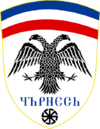Čěrneś
Čěrneś
Чърнєсь (South Ruthenian) Ґордъ Чърнєсѣ | |
|---|---|
| Borough of Čěrneś | |
| Чърнєсь transcription(s) | |
| • Romanisation | Čěrneś |
| Mottoes: South Ruthenian: Богомь (With God) | |
| Anthem: „Һєй, Словѣнє (Hej, Slovæne)“ "Hey, Slavs" | |
| File:Map of Gortynia (Arcadia).png | |
| Coordinates: 37°38’22.8"N 21°49’38.1"E | |
| Micronation | |
| Voivodeship | |
| Established | 20 August 2020 AD |
| Founded by | Quintus De Vitaliis |
| Seat | Kapsala |
| Districts | |
| Government | |
| • High Burghermaster | Quintus De Vitaliis |
| Area | |
| • Total | 0.021 km2 (0.008 sq mi) |
| Population (2023) | |
| • Total | 18 |
| Demonyms | Чърнєсьць (m.), Чърнєсьца (f.) |
| Languages | |
| • Official | South Ruthenian |
| • Regional | Hellenic |
| Time zone | UTC+02:15 (Græcian Eastern Time) |
| • Summer (DST) | UTC+03:15 (Græcian Eastern Summer Time) |
| Postal code | |
| Area code | +30 |
| Vehicle registration | CR |
The Borough of Čěrneś (South Ruthenian: Ґордъ Чърнєсѣ, romanised: Gordě Čěrnesæ, pronounced: [ˈgord(ə) ˈt͡ʃɤrnesæ]) is one of the boroughs of Græcia, the second-level administrative divisions of the micronation. It was formed in August 2020 AD. As of 2023 AD, it consists of four districts, all of which are located in an area of Gortynia, Arcadia, Peloponnese, Hellas.
Name
The Borough of Čěrneś was named after the previous name of its macronational location, a village that once went by the names of "Ts(i)aresi" or "Totaresi". This inspired Quintus to explore the area's obscure early medieval Slavic invader past, which gave birth to the borough's whole identity, revolving around this historical fact. This was also the spark that set in motion the development of the South Ruthenian constructed language. For the sake of brevity, the Borough is referred to as Čěrneś (South Ruthenian: Чърнєсь, romanised: Čěrneś [ˈt͡ʃɤrneɕ]). In Hellenic, the borough is known as «Ϝάστυ Τϻϸρνεσίου» (officially romanised as "Wásty Čörnesíu", alternatively as "Wásty Choernesíu", pronounced: [ˈwas.ti t͡ʃør.neˈsiu]) or, shortly, «Τϻϸρνεϡ» (officially romanised as "Čörneś", alternatively as "Choernes'", pronounced: [ˈt͡ʃørneɕ]).
Etymology
Čěrneś is a corruption of "Чьрнешь" (*Čьrnešь), one of the two Slavic names of the village where the borough is located. Ultimately, the source is the Slavic adjective *čьrnъ (cf. Old Church Slavonic ⱍⱃⱐⱀⱏ / чрьнъ, črĭnŭ), meaning "black".
History
The Borough of Čěrneś was formed on 20 August 2020 AD, alongside the boroughs of Andriopolis, and Hagia Aikaterini, making it one of the three original boroughs of Græcia.
Subdivisions
The Borough is subdivided into four districts:
| District | Area (m²) | Area of influence (km²) | Administrative seat |
|---|---|---|---|
| Kapsala | 8.000 | TBD | Mixo Auditorium |
| Moustretsa | 4.000 | TBD | Green Hall |
| Ćougově | 4.000 | TBD | Olive Grove Hall |
| Xŕb'tě | 5.000 | TBD | Dimitrijević Auditorium |
Government
Current High Burghermaster: Quintus De Vitaliis
The Borough assembly is composed of 8 counselors, organised as follows:
- Kapsala district representatives - 2
- Moustreca district representatives - 2
- Ćougově district representatives - 2
- Xŕb'tě district representatives - 2
Economy
The Borough of Čěrneś depends solely on agriculture. Quintus De Vitaliis, the sole heir of his father's properties located in the borough, produces olive oil, currently from one of the four available districts. One of his future plans is to plant more trees in two of the remaining districts, in order to maximize production.
Geography
The Borough of Čěrneś is located entirely in the area surrounding a village in Gortynia, Arcadia, Peloponnese. Its area of influence covers the whole village, as well as parts of neighbouring ones, ultimately within the bounds of the macronational municipality.
Demographics
Population
| District | Population (2023) | Citizens (2023) | Other subjects (2023) |
|---|---|---|---|
| Kapsala | 2 | 2 | 0 |
| Moustreca | 5 | 5 | 0 |
| Ćougově | 6 | 2 | 4 |
| Xŕb'tě | 5 | 5 | 0 |
Religion
All of the people living in the Borough are Greek Orthodox Christians. The patron saints of the Borough are Saints Cyril and Methodius, whose feast is celebrated on 11 May.
Language
The official language of the Borough is South Ruthenian, used for official documents, as well as everyday things. Hellenic serves as a recognised regional language, which means that there are people who speak it, but it does not appear in legal documents regarding the borough and its districts.

